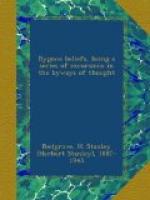It is not difficult to discern a certain truth in all this, making allowances for modes of thought which are not those of the present day. The Swedish philosopher SWEDENBORG (1688-1772) reaffirmed the theory in later years; but, as he points out,[2] the reason that man is a microcosm lies deeper than in the facts that his body is of the elements of this earth and is nourished thereby. According to this profound thinker, FORM, spiritually understood, is the expression of USE, the uses of things being indicated by their forms. Now, the human form is the highest of all forms, because it subserves the highest of all uses. Hence, both the world of matter and the world of spirit are in the human form, because there is a correspondence in use between man and the Cosmos. We may, therefore, call man as to his body a microcosm, or little world; as to his soul a micro-uranos, or little heaven. Or we may speak of the macrocosm, or great world, as the Grand Man, and we may say that the Soul of this Grand Man, the self-existent, substantial, and efficient cause of all things, at once immanent within yet transcending all things, is God.
[2] See especially his Divine Love and Wisdom, SESE 251 and 319.
IV
SUPERSTITIONS CONCERNING BIRDS
AMONGST the most remarkable of natural occurrences must be included many of the phenomena connected with the behaviour of birds. Undoubtedly numerous species of birds are susceptible to atmospheric changes (of an electrical and barometric nature) too slight to be observed by man’s unaided senses; thus only is to be explained the phenomenon of migration and also the many other peculiarities in the behaviour of birds whereby approaching changes in the weather may be foretold. Probably, also, this fact has much to do with the extraordinary homing instinct of pigeons. But, of course, in the days when meteorological science had yet to be born, no such explanation as this could be known. The ancients observed that birds by their migrations or by other peculiarities in their behaviour prognosticated coming changes in the seasons of the year and other changes connected with the weather (such as storms, etc.); they saw, too, in the homing instincts of pigeons an apparent exhibition of intelligence exceeding that of man. What more natural, then, for them to attribute foresight to birds, and to suppose that all sorts of coming events (other than those of an atmospheric nature) might be foretold by careful observation of their flight and song?
Augury—that is, the art of divination by observing the behaviour of birds—was extensively cultivated by the Etrurians and Romans.[1] It is still used, I believe, by the natives of Samoa. The Romans had an official college of augurs, the members of which were originally three patricians. About 300 B.C. the number of patrician augurs was increased by one, and five plebeian augurs were added.




